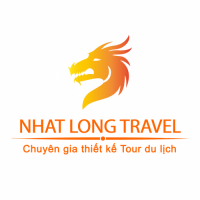|
Các bài viết trong September 2019
You need to know how to read maps, determine destinations, stops to explore Korea by subway. Subway is the main mode of transportation in Korea. For first-time visitors, it’s hard to read the map and find the train station. So you can refer to the note below:
Where is the subway station?
In Korea there are many subway lines. Of which Seoul has more than 20 ships in the city. To identify the train station, you may notice the yellow logo and the staircase going down. A little tip is that you can install some apps to find subway stations when traveling Korea. Alternatively, you can also ask the hotel receptionist or a taxi driver for instructions.

Options for subway tickets
Cash or a T-Money card are two ways you can pay for the trip by subway. You should use cash when traveling infrequently (less than 5 times), if using more should buy a card.
There are automatic ticket counters in the train station. You will receive a single trip card, in addition to the fare you have to deposit a 500 Won card (10,000 VND). After you’re done, you can go to the cash machine to return your card and get your deposit back.
Using T-money card, each train will get a discount of 100 Won (2,000 VND). You can buy T-Money cards at convenience stores and airports. To recharge your T-Money card, you can find automatic ticket vending machines at the subway stations and follow these instructions: Choose your language (machine with English, Korean, Chinese and Japanese settings). After placing the T-Money card on the device, choose the amount you want to top up and put coins or banknotes in. Finally you can take the card out and use it. T-money cards can be used when riding the bus, shopping at groceries, vending machines, and recharging phones.
Determine destination and how to read the subway map
The Korean subway map features multicolored lines and letters. If you understand the following rules, you will easily read the map and determine the destination.

First, you will count stops throughout the trip and list details, from the train station to the destination. Then follow the directions provided in the train and at the station. When traveling, note the change points so you do not get lost or missed.
Train culture in Seoul
You should wait for passengers to get out before entering the subway. Do not sit in a chair reserved for the disabled, pregnant women, the elderly. Always stand on the right of the escalator and avoid making noise, and do not eat on the train.
If you are planning to visit Vietnam, please see some exciting best Sapa tours such as Sapa Fansipan tour, Sapa package toursand Sapa vietnam motorbike tour or Sapa tours
Syria banned the Yo-yo game to overcome drought and the Dutch did not sing during meals to avoid the devil. Each country has different taboos. Therefore, you can refer to the information below to avoid trouble when traveling.
Japan: Poking chopsticks into food is something you shouldn’t do. Also, don’t use chopsticks to point at someone, to Japanese people, that act is rude and impolite.
South Korea: People think that turning on a fan while sleeping in a closed room or without a window can lead to death. This is especially noticeable with young children and the elderly.
Philippines: After returning from a funeral, people do not go straight home but have to visit a commercial center, shops or bars. This will make evil spirits mislead and unable to follow them home. People call this tradition pagpag.
India: Haircuts, manicures and shaving on Tuesday are said to bring bad luck. Therefore, barbershops in this country usually close on Tuesdays.
Egypt: Seeing the owl or hearing its cry means you are about to encounter a terrible disaster. This is also the reason they do not go to the forest at midnight.
Syria: In 1933, the game of ball on the Yo-yo line was banned. It is believed that the ball’s non-touching loop is the cause of drought.
Afghanistan: People forbid to touch whose feet the broom was touching. If you do, one of your loved ones will die.
Russia: People believe sending birthday greetings too soon to someone will cause them to encounter bad luck. If they want to organize a birthday party for relatives and friends, they will always choose the right date or for after the birthday. In addition, the Russians also believe that shaking hands, hugging and kissing goodbye at the door will make them enemies. Therefore, this sweet ritual should be performed indoors or outdoors.

Mexico: Placing two mirrors opposite one could open the door for the devil.
Lithuania: Whistling can be normal in many countries. However, for Lithuanians, whistling indoors is considered a way of summoning demons.
Brother: Leaving shoes on a table has a bad meaning, because it symbolizes the death of a loved one. In the past, someone’s shoes were placed on a table as a way of letting people know they were dead.
Turkey: Itchy right hand is believed that you are about to make a money, and itchy left hand means you will lose money. Turks also abstain from jumping over a child. This action meant to curse them short.
Iceland: In the winter, if you want to knit, do it indoors. Here, weaving outside the doorstep can make the cold season last longer.
Netherlands: Don’t sing during meals, as this is like inviting a devil to a meal.

Hungary: Sitting at the corner of a table can make you difficult in love, marriage and always lonely. This belief also appears in Russia.
Spain: Entering the house, entering the room with the left foot is considered unlucky. On the contrary, stepping in or out of the house with the right foot will bring good luck.
If you are planning to visit Vietnam, please see some our exciting Sapa tour Vietnam such as Sapa motorbike tour 1 day, Sapa package tours from Hanoi and Sapa trekking tours or Sapa tours
Reporting to the authorities, preparing the necessary documents to apply for a passport is what you should do when losing your passport.
Passport is one of the most important papers when traveling. If you accidentally lost your passport, you should do the following:
Report to the authorities
Crooks can take advantage of your passport while abroad. To protect your personal information, report it to the appropriate authorities such as the local police or Vietnamese consulate to confirm the loss of your passport.
First, prepare personal documents that contain personal information such as ID cards, identification cards or air tickets. You can also apply for a booking confirmation form at the hotel you are staying at. Then contact the local police to complete the passport verification procedure.

After being granted the confirmation, you can go to the nearest Vietnamese consulate or embassy for assistance with the procedures for issuing laissez-passers or temporary passports.
Necessary documents
To issue a temporary passport or passport, you need to prepare: 2 4×6 photos, confirmation of the passport of the local police, proof of Vietnamese nationality such as ID card, air ticket, confirmation Hotel reservation or immigration declaration. When you have all of the above documents, you will be issued a travel document back to Vietnam by the consulate or Vietnamese embassy. In case you continue traveling to another country, you will be issued a temporary passport.
Visas to other countries will not be valid when you lose your passport and you need to apply again if you want to enter the next time.
Contact family
If you are traveling on your own and do not bring your ID card, try to contact your family and relatives. You can ask them to take photo identification documents such as ID card, driver’s license … to apply for a temporary passport and passport.

If you go on a tour, you can also present the incident to your guide for timely assistance. When traveling with a group, the procedure to apply for a temporary passport or laissez-passer is simpler. In which conditions required is accompanied by a personal passport and confirm you are a member of the delegation.
Contact the insurance company
When losing your passport or luggage, you should contact the insurance company for instructions on necessary procedures. When you return home, you may receive assistance with the cost of losing your passport.
To avoid trouble, visitors should carefully preserve their passports. Always take your passport with you wherever you go. Avoid holding a passport in two hip or rear pockets, in case an intruder steals your passport.
If you are planning to visit Vietnam, please see some exciting Sapa Vietnam tours such as Sapa trekking tour, Sapa package tourand Sapa motorbike tour or Sapa tours
Thanh Toan bridge is one of the few bridges possessing extremely unique architectural features in Vietnam. Because of its unique beauty, this project has become a famous and attractive place for many tourists from Vietnam and other countries to visit every year.
About the history of Thanh Toan bridge
According to some documents, recorded historical records, this famous tile bridge in Hue was built in 1776, thanks to the great merits of a woman named Tran Thi Dao. She is the 6th grandchild of one of the 12 who had publicly reclaimed and built Thanh Thuy village, holding the position of “special patriarch of the army general to protect the deputy governor”. Her husband was a big official in the court at that time. At one point, she followed her husband to the North to live, but only a while later she returned to her hometown.
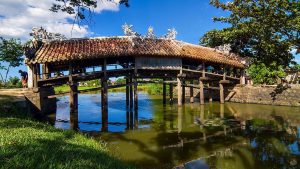
In the small village where she lives there is a river flowing through. People in the village working on the fields on the other side of the river have to row boats, travel activities must be attached to boats and boats, so it is quite hard and time-consuming. Through the rainy, dry and bitter seasons, seeing the villagers all having a hard time to cross the river, she thought there must be something to change this. With the virtue and compassion for the villagers, she spent her own money to build a bridge for people to travel more conveniently. The bridge can also be used as a place to stop, relax, meet, talk to people in the village.
Road to Thanh Toan bridge
Address: Thanh Thuy Chanh Village, Phu Vang, Thua Thien – Hue
Get directions to Thanh Toan tile bridge
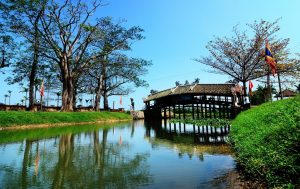
Located in the outskirts of Hue, about 7-8 km from the center to the Southeast. The route is not too far, and there are many routes to this place. If you start from the center of the city, you can go straight to To Huu Street, turn right then, go to the intersection of Hoang Quoc Viet Street and turn left from here, you will go straight to the Ngoi Bridge Market. will arrive.
The road to this location is close and easy to go, but the road is quite narrow so you can only make your trip by bike or motorbike.
Architecture of Thanh Toan bridge
Fishing rods with unique architecture such as Thanh Toan tile bridge are no longer many. In the North, you can come across this architecture again at Phu Khe and Khuc Thoai bridges. Central Vietnam also has Cau Pagoda in Hoi An and Thanh Toan tile bridge. These bridges are built in the “upper house of upper house” architecture (above the house, below the bridge), and are appreciated for artistic value.
This bridge is built on a system of 3 pillars made of wood, each row consists of 6 columns, the support columns are made of stone. To prevent subsidence, the rows of columns are connected by a mortise block. Two bridges are placed at both ends, the focal points are connected to the system of support pillars, concrete bars. This bridge is also built with 7 drainage systems.
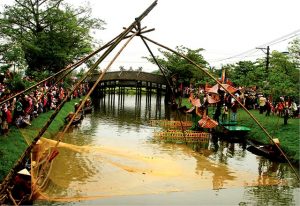
At the two ends of the bridge, the support rods that run along the middle of the bridge were broken to the upward section to create a curved shape for the bridge, partly to create a certain height to help the ships and boats pass more easily. The pillars are also connected by large, horizontal wooden trunks. From the timber will build the column to build the upper house. The two sides of the bridge with 4 rows of columns, in the middle are to support a walkway. Outside, the bridge is attached with a wooden railing to make it safer.
In the nave, there is an altar should be sealed, the rest is ventilated. Designed according to the old architecture, Thanh Toan tile bridge in Hue has the tie beams systems made in the form of double beams, the lower beams will go through the mast, the upper beam will be placed on the ends. column.
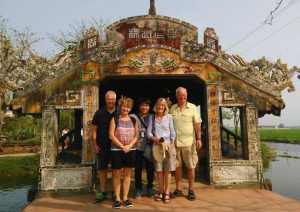
Most of the bridge’s support parts are made of wood, but on the columns, the beams are not carved, instead they are merely two types of square and round sections. As for the roof, the bridge is meticulously carved by artisans with the theme of the four spirits with the image of Long – Lan – Quy – Phung. Previously, the roof was decorated with a Giao Long, but later it was replaced by a pair of flanking phoenix in the middle and two stylized dragons.
Unique features at Thanh Toan bridge
This bridge has a total length of 16.85 meters, a width of 4.63 meters, and is divided into 7 spaces. From the outside look at you will see the overall bridge has the shape of a house. It is just an outside feeling, but when you step inside you will find it more true, because it is divided into 7 rooms as 7 small rooms of a house. When you enter a traditional house, you will also see an ancestor altar usually placed in the middle, as well as this bridge. An altar is placed in the middle of the bridge to worship and pay homage to the people who have contributed to the construction of this project. On both sides, each side has 3 compartments made of high podiums like tables and chairs in the house. This is also a typical architecture of bridges built in the style of “upper house of upper house.”
Coming here to hear about Thanh Toan tile bridge, you will see that this bridge is not only built for the purpose of helping people travel more conveniently, but it is also a place to stop from rain, sun or cool in. sultry summer noises. Perhaps that is why this bridge was built as a house across the river.
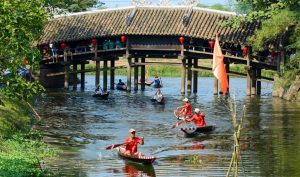
At the top of the bridge you will see a large area. This is the place where often the fun activities, meetings, trade of the guides in the village. Near the bridge, there is also a communal house, this place is often the place where village festivals, community activities, as well as trade, markets are held.
Every year, on the third day of the Lunar New Year, the Bai Choi festival is held here. And on August 15 of the Lunar Calendar, a festival is also held very grandly here. According to the people, this day is the anniversary of the death of Mrs. Tran Thi Dao. During the festival, people will pick her up from the communal house to pray for a ceremony, then take her back to the communal house. After the rituals are completed, it will be time for fun activities, folk games such as tug of war, boat racing on the river, pounding rice … will take place. In addition, every 2 years a rural fair is also held here.
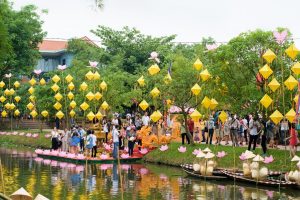
Dating back more than 200 years, Thanh Toan tile bridge has become an indispensable part of the people of Thanh Thuy village. Not only possessing high artistic values, it also brings tremendous spiritual value. If you have the opportunity to visit the dreamy Hue, you should not miss this attractive tourist destination.
So what do you expect more for a great trip? Please contact us – Asia Master Tours for guidance, advice and get the most preferential price when you, your family and friends are going to enjoy Hue city.
You can explore more information about Hue such as Hue Vietnam resorts and Hue Vietnam weather or see our exciting Sapa tours from Hanoi such as Sapa Motorbike Tours, Sapa Package Tour and Sapa Trekking Tours.
Contact Us
Address: 272 Khuong Dinh Street, Thanh Xuan District, Hanoi, Vietnam
Phone: (+84)24 6293 4678
Email: [email protected]
Hotline: (+84)962 313 698
Website: http://www.asiamastertours.com
For a long time, the songs about Hue have come into people’s hearts, dreamy and peaceful Hue, especially Hue people are simple, close and quiet. Hue is known for its landmarks associated with the heroic history of the nation and beautiful landscapes, not only that, coming to Hue you will enjoy the famous delicious dishes such as banh xeo, mussel rice or Che Hue. … These are the reasons why Hue has become a destination for many people. If you choose Hue to travel, let’s refer to some of Hue Vietnam things to do that I share below.
Time to go to Hue
If the climate of the whole country is divided into two seasons, dry and rainy, Hue has only two other seasons: rainy season and little rainy season. The rainy season lasts from September to the end of December, the little rainy season lasts from the end of December until about April. The remaining months of Hue weather are sunny due to Hue is also in the area of abundant heat radiation and heat background. high. Tourists come to Hue at different times. If domestic tourists usually come to Hue from early May until the end of September, foreign tourists come to Hue between October and the end of April. The best weather in Hue is usually in November. You can refer to some reasonable time to go to Hue as follows
Around March every year, the weather in Hue is still relatively cool, it rarely rains so you can go to Hue on this occasion, especially families with children and the elderly.
On the occasion of April 30, Hue usually organizes festivals with lots of unique cultural activities, in addition to this, there is also an international fireworks festival in Danang, you can schedule a trip. Hue calendar combined with Da Nang tourism always.
Directions to Hue
Planes
Currently, from Hanoi, there are only 2 units: VietjetAir and Vietnam Airlines operating flights to Hue, with the afternoon from Saigon there will be more Jetstar, the ticket price from time to time will be about 2000k-2500k round trip from Hanoi and about 1500k-2000k with the afternoon from Saigon. Phu Bai Airport is about 40km from Hue city center, you can use the bus service to take guests from the airport to the city center with the fare of about 50k / 1 person.
Train
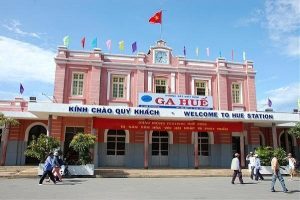
From Hanoi and Saigon train stations, there are 5 Thong Nhat trains departing for Hue daily according to the train schedule as shown below, depending on the specific plan that you choose.
SE1 and SE2 trains: [Hanoi 19h30 – Hue 8:48] [Saigon 19h30 – Hue 15h23]
SE3 and SE4 trains: [Hanoi 22:00 – Hue 10:27] [Saigon 22:00 – Hue 16:00]
SE5 and SE6 trains: [Hanoi 9:00 – Hue 22:42] [Saigon 22:00 – Hue 5:31]
SE7 and SE8 trains: [Hanoi 6:00 – Hue 19:00] [Saigon 6:00 – Hue 1:28]
Train TN1 and TN2: [Hanoi 13h10 – Hue 3h39] [Saigon 13h10 – Hue 12h06]
In addition to the Thong Nhat trains, from Hanoi there is also the SE19 train to Da Nang, this train leaves from Hanoi Station at 8am and arrives in Hue at around 10am.
High quality passenger car
From Hanoi and Saigon every day there are many high-quality bus routes to Hue, open tours to Hue, travel time is about 13 hours (from Hanoi) or 25 hours (from Saigon).
Vehicles in Hue
Cyclo
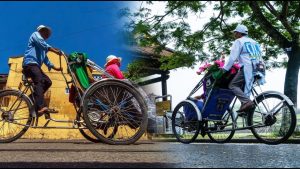
Cyclo in Hue is convenient because of its wide and high roof, when necessary, it is possible to carry goods or it can be turned on for passengers to politely and safely. Transport service by cyclo is the most attractive and suitable in the inner city. Using cyclo, you can take a leisurely stroll around this ancient and beautiful city.
Bicycle / Motorcycle
With the advantage of being a tourist city, you can easily find yourself a suitable bike or motorcycle. Bicycle and motorbike rental locations are concentrated in Hung Vuong street, the distance from Truong Tien bridge to Hung Vuong intersection and Nguyen Tri Phuong. The second area is Le Loi Street, the Western Quarter opposite Huong Giang Hotel, the roads like Pham Ngu Lao and Chu Van An have car rental. Hue Vietnam things to do.
Stay in Hue
Hotels in Hue
There are about 600 accommodation establishments with nearly 10,000 rooms and 17,000 beds in Hue so there is almost no room fire in Hue. You can find yourself the right hotel through the list of motels in Hue, or you can refer to some of the options that Phượt offers below.
For the majority of you traveling, often need only a relatively reasonable place to stay because in fact the entire time of the day is on the road, with this demand, the 2-star hotel is quite suitable by relatively reasonable price (usually only about 300k). If you want a little more quality (usually can be a nicer location, more comfortable room facilities) you can choose 3-star hotels.
If you come to Hue in the summer, the weather is especially sunny and quite hot, the needs of most people will probably want to drop in the cool water for entertainment. If you do not choose to stay at hotels and resorts near the sea (but are far from the center), you can choose hotels with swimming pools in Hue. After a day out, returning to the hotel and swimming is not a bad idea.
Finally, if there is economic conditions, why not try to stay and experience the service of 4-star hotels and 5-star hotels in Hue? Despite the high cost but certainly what you receive will make you extremely satisfied.
Homestay in Hue
Meeting the needs of the young, those who love to travel but do not have a generous budget, the form of homestay has been born, meeting the needs of beautiful space, good service and still affordable prices. reasonable. Unlike the traditional homestay form, which must be shared with the host, the new type of homestay allows tourists to enjoy private space. Most homestays are now apartments separate from the owner. In particular, these locations are often beautifully decorated. Typically, a standard homestay will have a nice small garden, thanks to which, tourists will feel familiar, close, like being at home.
Sights in Hue
Referring to Hue, people remember the gentle girl in purple dress, and the city that has a thoughtful beauty that is deep, simple and memorable. Traveling to Hue, you will admire the ancient beauty of the high-value historical sites located in Hue Monuments Complex such as Kinh Thanh Hue, Tomb of Minh Mang, Tomb of Gia Long, Thien Mu Pagoda, Van Temple and Quoc Hoc High School … Let’s see the tourist attractions not to be missed when in Hue yet.
Hue Imperial Citadel
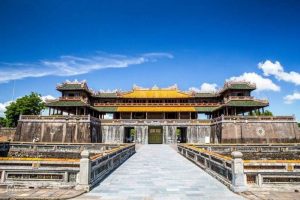
The Imperial Citadel is the second citadel within the Imperial City of Hue, which protects the most important palaces of the royal court, the Nguyen ancestral shrines and the Forbidden Purple guard – a place reserved for kings and royalty. . People often call the Imperial Citadel and the Forbidden City the Great Citadel.
Hue Museum of Fine Arts
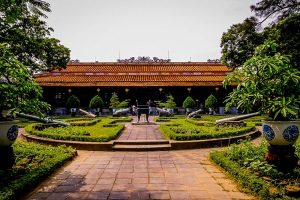
Hue Museum of Fine Arts is a museum at 3, Le Truc, Hue City. The main building of the wooden museum, there are 128 precious wooden pillars, on the columns are carved with four spirits: long – li – quy – serving and more than 1,000 poems in Chinese characters. This building is the Long An palace built in 1845 under the reign of Hien’s ancestor of the Nguyen Dynasty, named Thieu Tri. Currently the museum displays more than 300 artifacts of gold, crockery, porcelain, pham lam Hue, royal medicine and crafts, costumes of the Nguyen royal court, giving visitors an overview of Hue royal life. Hue Vietnam things to do.
Huong river
Perfume River has two sources. The Ta Trach source originates from the Truong Son mountain range, which flows to the northwest through 55 majestic waterfalls, the shorter Huu Trach source after passing 14 rugged waterfalls and reaching the Bang Lang junction (Tuan junction) in line with Ta Trach into the romantic Perfume River. The Huong River is 30 km long (if only from Bang Lang to Thuan An estuary), the slope of the water flow from the sea surface is not much different, so the river water flows slowly. The color of the Perfume River becomes greener when crossing the foot of Ngoc Tran mountain – Hon Chen palace, creating a deep abyss.
Ngu Binh Mountain
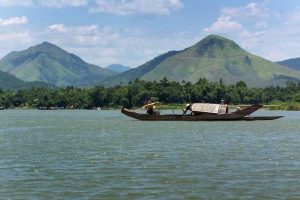
Ngu Binh mountain (also known as Bang Son) is 105 m high, with a majestic balanced figure. On both sides of Bang Son, there are two small mountains flanking in, called Ta On Son and Huu On Son. When the Nguyen Dynasty built Hue citadel, this mountain was chosen as a precedent of a massive and fortified defensive system and the name was changed to Ngu Binh.
Together with Huong River, Ngu Binh Mountain is the second invaluable gift of creation, intertwined to create the charming charming beauty of Hue. For a long time, this beautiful mountain and the blue Perfume river have become a symbol of Hue’s nature. People used to call Hue the country of the Huong River – Ngu Mountain, Huong Ngu Region.
Gia Long Mausoleum
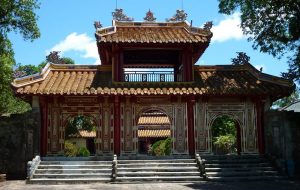
Gia Long Tomb, also known as Thiên Thọ, began to be built in 1814 and was completed in 1820. Lang is actually a complex of many tombs in the royal family. The entire mausoleum is a mountain complex with 42 hills and mountains, large and small, of which Dai Thien Tho is the largest mountain chosen as a precedent of the mausoleum and is the name of the whole mountain.
Minh Mang tomb
The tomb of Minh Mang, also known as Hieu, was built by King Thieu Tri from 1840 to 1843 to bury Minh Minh’s father. The mausoleum is located on Cam Khe Mountain, near the Bang Lang T-junction where the confluence of the Huu Trach and Ta Trach rivers form the Huong River, 12 km from Hue.
Tomb of Tu Duc
Tomb of Tu Duc was built by King Tu Duc while still in his position, a complex of architectural works, including the burial ground of King Tu Duc located in a narrow valley of Duong Xuan Thuong village, Cu Chanh district. (old), now is Thuong Ba village, Thuy Xuan ward, Hue city. When newly built, the tomb was named Van Nien Co. After the Chay Voi rebellion, Tu Duc changed its name to Khiem Cung. After Tu Duc’s death, the tomb was renamed Khiem Lang. The mausoleum has elaborate architecture, charming scenery and is one of the most beautiful tombs of the Nguyen Dynasty.
Phu Cam church

Phu Cam Cathedral is the cathedral of Hue Archdiocese, located on Phuoc Qua hill, located in Phuoc Vinh ward, Hue city. This is one of the largest, famous and oldest churches in Hue. The church today is built in modern architecture, designed by architect Ngo Viet Thu.
In terms of architecture, the church building ground is in the form of a cross, head facing south and tail north. The church has a structure based on modern construction techniques but the decoration still follows the classical art of the West. The pillars are molded close to the wall, running forward, soft. The four corners of each corner have three pillars reaching outwards, forming a space large enough to cover the sanctuary and the altar. Hue Vietnam things to do
Tinh Tam Lake
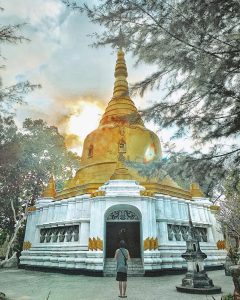
Tinh Tam lake is one of the famous sights of the capital city, now in Thuan Thanh ward, Hue City. In the past, the lake was a part of the renovated Kim Long River, the original name was Ky Te pond. In the third year of Minh Mang’s reign (1822), the Nguyen Dynasty mobilized up to 8000 soldiers to take part in renovating the lake, turning it into a royal royal throne. After completion, the lake has a new name: Tinh Tam. things to do in hue city vietnam
Tinh Tinh Lake has a rectangular shape with a perimeter of nearly 1500m (354 cadres 6 meters). On the lake are three islands Bong Lai, Phuong Truong and Doanh Chau. Bong Lai Island, in the south of the lake, is in the middle of the Bong Doanh Palace, 3 compartments with 2 wings, identical matches, and tiles of Hoang Luu Li. Power is built to the south, surrounded by brick railings, the front is Bong Doanh gate, and Bong Doanh bridge connects the island to the southern lake. On the east side of Bong Doanh palace is Thanh Thuy weightlifting house, facing east. The west of the palace has Chenghai floor, facing west. To the north is Hong Cu gate and a bridge of the same name. Hue Vietnam things to do.
Thien Mu Pagoda
Thien Mu Pagoda, also known as Linh Mu Pagoda, is an ancient pagoda located on the hill of Ha Khe, on the left bank of the Perfume River, about 5 km to the west of Hue City (Vietnam). Thien Mu pagoda was officially established in Tan Suu (1601), the first royal lord Nguyen Hoang Hoang – the first Nguyen lord in Dang Trong.
Tu Dam Pagoda
Tu Dam Pagoda is a famous ancient temple in Hue; Currently located at 1 Su Lieu Quan Street, Truong An Ward, Hue City.
The pagoda was painted by the Zen master Minh Hoang – Tu Dung in the late seventeenth century, and was later named Indo-Ton (or Tong) pagoda, with the meaning of “taking the mind transmission as a guide.”Hue Vietnam things to do
Thien Lam Pagoda
Thien Lam Pagoda was founded by the Venerable Ho Nhan in 1960. The reason was that in 1958, the Church nominated him from Tam Bao to head the temple of Tang Quang; After a short time, he realized that the monk’s meditation and his life, Tam Su Nhat Bat raised his life with alms injustice here, so in 1960 he went to Thuong II village, Thuy Xuan commune, built a small house. in the hill of Quảng Te (now Thôn Thượng II, Xã Thủy Xuân, Huế City) to practice.
Thien Lam Pagoda (also known as the “standing Buddha – Buddha”) was built in 1960 by Ho Nhan monk with the original form of a small Coc. Until now, the pagoda is a complex of many architectural works such as statues, tombs, Buddha towers, houses of monks … in many different positions.things to do in hue city vietnam.
Thanh Toan tile bridge
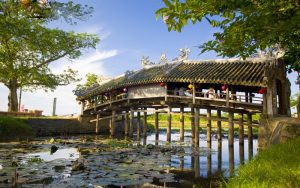
Thanh Toan Tile Bridge is a wooden arch bridge with a tile roof crossing a ditch in Thanh Thuy Chanh village, Thuy Thanh commune, Huong Thuy town, Thua Thien – Hue province, about 8 km southeast of Hue city. . This is a wooden bridge classified as rare and has the highest artistic value among the ancient bridges in Vietnam. Hue Vietnam things to do
Thanh Toan tile bridge is built according to the “upper house of upper house” (above the house, below the bridge). The bridge is 43 meters long (18.75m), 14 meters wide (5.82m) wide, divided into 7 spaces, the two sides of the bridge have two rows of wooden platforms and railings to sit on. On a covered bridge, roofed with glass tiles. The first bridge, built more than two centuries ago, has been devastated by storms, floods and wars. However, after the damage, the commune people repaired, embellished and preserved together.
The delicious food in Hue
Hue especially preserves over 1,000 dishes cooked in the Hue way, including the friendly dishes of the Nguyen kings. The friendly menu contains over a dozen dozens of delicacies, prepared and organized meticulously, meticulously and elaborately. Popular dishes are popular among the masses with a rich menu of hundreds of dishes cleverly and cleverly processed by Hue housewives with good cooking techniques, attractive flavors, attractive colors. , attaching much importance to quality over quantity; The art of displaying the dishes is very beautiful, the art of exquisite enjoyment. In addition, if anyone has ever enjoyed a Hue vegetarian meal (dishes made from plants), surely will never forget the wonderful pure taste of Hue dishes. things to do in hue city vietnam
Festival in Hue
Thua Thien Hue is a land of cultural traditions, though not as old as the North, but also has more than 700 years of history. From the time when Lord Nguyen put the capital here until the time of Nguyen’s death (1945), it can be said that Hue is a meeting place of great cultural activists and a meeting place of East-West thought flows. ancient needle. Hue culture has traditionally come from the North, following the settlers living in the new land. Here the Cham people still exist with Indian culture. And later Western culture also had the opportunity to penetrate from the time of the Nguyen Lords. Traditional festivals are maintained and developed from these cultural sources.
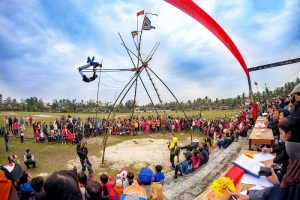
Festival of all kinds is a need of cultural activities of people in Thua Thien Hue has become a tradition. Overview of the festival and the participation of the residents in this region, we will see that the festival in Thua Thien Hue is not as rich as the North, but it is quite diverse, there are two types of festivals: bow festivals communal house and folk festival. The royal festival reflects the ritual activities of the Nguyen Dynasty, mostly focusing on “ceremony” rather than “festival”. Folk festivals of many types are very diverse, including some typical festivals as follows: Hue Nam festival (Hon Chen palace), also known as the procession of the goddess Thien YA Na according to the beliefs of the people Ancient Champa, the festival commemorates the birth of traditional occupations, the festival commemorates the founding of the village. In ceremonial occasions, many useful cultural activities such as boat racing, tug of war, wrestling … are also organized and attract a large number of viewers. Hue Vietnam things to do.
So what do you expect more for a great trip? Please contact us – Asia Master Tours for guidance, advice and get the most preferential price when you, your family and friends are going to enjoy Hue city.
You can explore more information about Hue such as Hue Vietnam resorts and Hue Vietnam weather or see our exciting Sapa tour from Hanoi such as Sapa Motorbike Tour, Tour Sapa Fansipan and Sapa Trekking Tour.
Contact Us
Address: 272 Khuong Dinh Street, Thanh Xuan District, Hanoi, Vietnam
Phone: (+84)24 6293 4678
Email: [email protected]
Hotline: (+84)962 313 698
Website: http://www.asiamastertours.com
Nestled in a place that is not noisy and bustling, Thien Mu Pagoda Hue still attracts cross-tourists when coming to Hue because of the stories and mysterious dialogue, by the beauty of solemn and peaceful beauty by the poetic Perfume river.
1. Location of Thien Mu Pagoda
Thien Mu Pagoda (also known as Linh Mu Pagoda) is located on Ha Khe hill, on the left bank of Huong River, about 5 km west of Hue city center in Huong Tra district. Thien Mu Pagoda was officially founded in Tan Suu (1601) during the reign of Lord Nguyen Hoang – the first Nguyen Lord in Dang Trong.
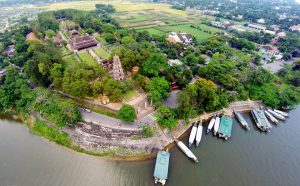
Before the time of setting up the pagoda, there was a pagoda also named Thien Do (Thien Mau) on the hill of Ha Khe.
According to legend, when Lord Nguyen Hoang came to be the Governor of Thuan Hoa, he personally went to examine the terrain here in order to prepare a scheme to expand the land and build Giang Son. In a horse hike along the banks of the Perfume River looking upstream, he encountered a small hill rising on the banks of the meandering blue water, the earth was like a dragon turning back to look back – this hill had His name is Ha Khe.
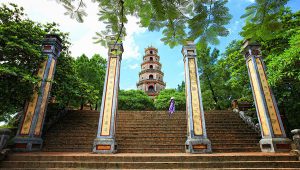
Local people said that there was often an old lady in red pants with green pants appearing on the hill at night telling people: “Then there will be a lord to come to the temple to gather spiritual energy, to make a lasting circuit, for the mighty South country ”. So this place is also known as the sacred name Thien Mu Son.
The thought of Lord Nguyen Hoang seems to have caught up with the wishes of the people, Nguyen Hoang is happy, in 1601 Lord Nguyen built a temple on the hill, overlooking the Perfume River and named it “Thien. Mu ”.
2. Architecture
Under the Nguyen Lords, Thien Mu Hue Pagoda underwent many major renovations. Among them, the highlight is the expansion of the scale under Lord Nguyen Phuc Chu (1691-1725). In addition, the Lord (another name of Lord Nguyen Phuc Chu) also cast Dai Hong Minh – a large bell, weighing over two tons in 1710, engraved with an intelligent card on the bell. By 1714, the Lord continued to renovate a series of architectural works of scale such as Thien Vuong palace, Dai Hung palace, the sermon, the Tang Kinh … God also personally wrote the article, carved into stone steles. Great talk about the construction of buildings in the temple. In particular, Lord Nguyen Phuc Chu also sent people to China to buy more than 1,000 Buddhist scriptures and put them at the Tang Kinh floor, praising the Buddhist philosophy and stating the legend of Venerable Thach Liem – a person with great merit in help Lord Nguyen revive Buddhism in Dang Trong.
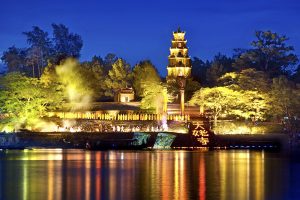
With a great investment, Thien Mu became the most beautiful temple in Dang at that time and was one of the extremely famous Hue tourist destinations. In 1788, the Tây So’n Dynasty chose the pagoda to be the place where Te Dan was located. Under the reign of Thieu Tri, around 1844, Thien Mu Pagoda was built an octagon tower named Tu Nhan, later renamed Phuoc Duyen. The tower was built in front of the pagoda with a height of 21m, including 7 floors and each floor has a worship of Buddha statues, the top floor has a golden Buddha statue. This is the architecture associated with Thien Mu pagoda.
In addition, King Thieu Tri also built Huong Nguyen temple in front of the tower. On the roof of the temple, there is a Falun – the wheel of Dharma – a symbol of Buddhism. But in 1904, the communal house was collapsed by a big storm ceiling. By 1907, King Thanh Thai rebuilt the pagoda but the scale was not as large as before. Currently, Thien Mu Pagoda holds two Vietnamese records, the largest pagoda in the Le Trung Hung period and the tallest octagonal pagoda in the temple. In addition, the pagoda is also classified as a list of 20 landscapes of Neurological land and is an indispensable destination in Hue 1-day tours.
3. Landscapes in Thien Mu Pagoda
Dai Hung Palace
As the main house in the temple, the architecture is identical to that of scallops. The temple was restored in 1959, the rafters are built of concrete outside is a layer of fake wood paint. In the temple, the statue of Buddha Maitreya laughed generously. In the sky on the sky, there are 4 words “Linh Thuy Cao Phong” by Lord Nguyen Phuc Chu in 1714.
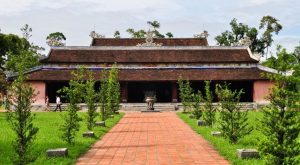
Dia Tang Palace and Quan Am Palace
Located behind Dai Hung Palace, a large yard of ornamental trees, fruits, inside the temple. The place of worship Quan Cong (since 1907). According to legend, after his death, Quan Cong became aware of the future of yin and yang, so although the temple is a place of worshiping Buddha, in Quan Cong temple, people often worship a whole set of tattoo cards and monks at the temple always do guess work for those who come to tattoo.
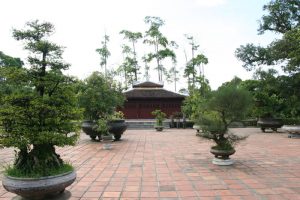
Phuoc Duyen Tower
This is a famous symbol associated with Thien Mu Pagoda Hue. This is also known as Phuoc Duyen Buu Thap. The bowl-shaped tower is 7 storeys high, large and small. Number 7 is the spiritual number of Buddhism. The first floor is to worship Buddha Past The Bhikkhu Thi, the second floor is to worship Buddha Thi Khi, the third floor is to worship the Buddha Xa Xa, the fourth floor is to worship Buddha Luu Ton, the fifth floor is to worship Buddha Na Ham, the sixth floor to worship Buddha. Ca Lettuce, the seventh floor, worships Shakyamuni Buddha, the Western Land of Blissful Dharma King.
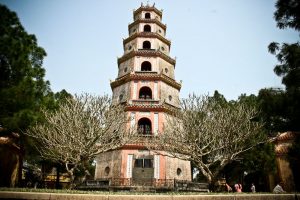
Those who come to Hue visit this spiritual place with the psychology of praying for good luck for relatives and friends around. Thien Mu Pagoda is a building that serves the spiritual life of Hue people, and is also a great contributor to the beauty of Hue – the unique beauty unique to the nerve land, the highlight. statues in the cross tourists travel to Hue.
So what do you expect more for a great trip? Please contact us – Asia Master Tours for guidance, advice and get the most preferential price when you, your family and friends are going to enjoy Hue city.
You can explore more information about Hue such as Hue Vietnam resorts and Hue Vietnam weather or see our exciting Sapa tour from Hanoi such as Sapa Motorbike Tour, Tour Sapa Fansipan and Sapa Trekking Tour.
Contact Us
Address: 272 Khuong Dinh Street, Thanh Xuan District, Hanoi, Vietnam
Phone: (+84)24 6293 4678
Email: [email protected]
Hotline: (+84)962 313 698
Website: http://www.asiamastertours.com
Each time coming to Hue, it is unknown how many people are sobbing before the poetic and lyrical beauty of the Perfume River. This river has consumed the poet’s paper with those who carry heavy nostalgia for Hue. Perfume River in Hue is like a gentle silk ribbon surrounding Hue. Coming to the ancient capital without enjoying the beauty of the river is considered as yet to set foot in Hue.
About the Perfume River
Since ancient times, the Perfume River flows through the forests bearing the fragrance of herbs. When coming to Hue, the Perfume River is beautiful from the source, winding with the scent of natural plants as an arrangement that nature bestowed on this land.
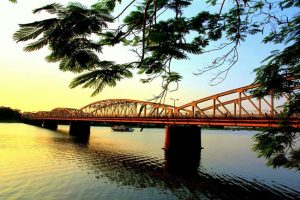
The Perfume River flows through the Imperial City, Imperial Citadel, Forbidden City and the Inner City, further embellishing the natural beauty of this unique feudal capital. Huong River has a length of up to 80km, particularly the section from Bang Lang to Thuan An estuary is 30km long.
The slope of the water flow from the sea surface is not much different, so the river water flows slowly. The part of the river running through Hue meanders like a natural arrangement in order to embellish the beauty of Hue city. Perfume River is an invaluable gift that nature has dedicated to this land. This river is a decisive factor for the ancient people to choose Hue as the capital, a convergence of Hue landscape and cultural heritage.
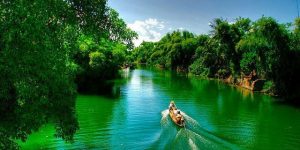
The Perfume River in Hue has two large tributaries, both of which originate from the Truong Son mountain range. Ta Trach branch comes from Long cave, flows through 55 large and small waterfalls to Bang Lang junction. The Huu Trach branch starts from the east of Chan Son mountain, flows through 14 falls and joins the Ta Trach stream at the upper junction. From Bang Lang T-junction to the sea the river becomes spacious, the water flows smoothly.
The Perfume River’s water is green all year round except during floods. From Bang Lang T-junction, the Perfume River flows gently and slowly through the rich villages of the outskirts of Hue, deep into the heart of the city, and then continues to meander through the countryside downstream before reaching the sea. .
The beauty of the Perfume River
Citadel, citadel, architectural works on both sides of the river reflect the silhouette into the river like a picturesque feng shui picture. The Perfume River is as charming as a Hue girl, smiling shyly under a conical hat. The silvery white color of the river is further embellished when the Trang Tien Bridge crosses the Perfume River.
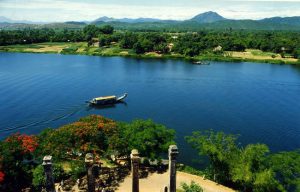
Huong River leads the way down the water to take visitors to visit Vy Da beauty garden with lush green grass garden. There is nothing more wonderful than being upstream to Thien Mu to drop your soul in the temple bell. From the pagoda, you can watch the whole beauty of Huong Giang like a maiden’s shirt changing colors several times a day.
Goodbye sacred temple in Hue, you suddenly turn into the Bach Yen River to Huyen Khong. The ancient space here along with cloudy wind, with the world of sweet and fragrant flowers makes your soul so gentle and pleasant.

Following the curves of the Nguyet Bieu village, the green of the Huong River with the mudflats and the green of trees and hills create a poetic landscape. Stop at Tu Duc mausoleum, you will admire the wonderful beauty of the Perfume River. This is an unprecedented place on any tourist map, but do not miss it. To this day, it is still an interesting point of observation of Hue city.
Upstream to the upstream, for boats to Hon Chen power station. Huong River embellishes the peaceful beauty here. Your soul is freed along with the mountains, temporarily putting aside all troubles of life.
Under daylight, the emerald green shimmering of the river, the boats floating on the water make visitors unforgettable. Going on a boat to admire the beauty of Huong Giang, dropping flower lanterns or listening to Ca trù, Hue folk songs in the middle of the night at a lonely night is an elegant pleasure hard to compare.
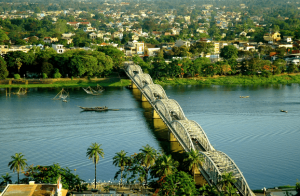
Huong river and Ngu mountain become permanent symbols of Hue ancient capital. Referring to Hue, visitors immediately remember the poetic Huong River downstream. Throughout the year, that peaceful river flows around the city, highlighting the beauty of this land. The inherent beauty of the green river has brought to the city the quiet poeticness emanating from the land of deep culture.
Hue is not only a political, cultural and religious center of the Nguyen Dynasty until 1945, but it is also more beautiful when the Perfume River flows through it to embellish the natural beauty of a feudal capital. this nicely. If you have the opportunity to travel to Hue, please do not forget the dragon boat watching the Perfume River in Hue through every moment, surely you will be unforgettable in the journey to the ancient Kinh land.
So what do you expect more for a great trip? Please contact us – Asia Master Tours for guidance, advice and get the most preferential price when you, your family and friends are going to enjoy Hue city.
You can explore more famous places in Hue such as Minh Mang tomb and Tu Duc tomb or see our exciting Sapa tours from Hanoi such as Sapa Motorbike Tour, tour Sapa Fansipan and Sapa Trekking Tour.
Contact Us
Address: 272 Khuong Dinh Street, Thanh Xuan District, Hanoi, Vietnam
Phone: (+84)24 6293 4678
Email: [email protected]
Hotline: (+84)962 313 698
Website: http://www.asiamastertours.com
Always saying “Itadakimasu” and “Gochisou-sama” are things tourists should do to start and end a Japanese meal.
Cuisine in the country of cherry blossoms has many special dishes, which need to be eaten in a specific way. Please pocket a few rules on the Japanese table.
Say “Itadakimasu”
Japanese always say “itadakimasu” before eating. You should do the same when having meals with locals or in Japanese restaurants. Literally, this phrase can be understood as “humbly welcoming” or “fortunate to enjoy this meal”. You can understand this is simply a delicious greeting.
Miso soup

Many people will be surprised to find Japanese people eating miso soup (miso shiru) with chopsticks. The way to hold a soup bowl is like eating white rice. Because there is no spoon, Japanese people often drink soup from a bowl. They can use one or both hands to lift the soup, then use chopsticks to pick up the bits and pieces inside.
Side dishes

A typical Japanese meal often includes several different side dishes (jikabashi). These items are divided into small portions and displayed on separate plates for each person. People will use their chopsticks to pick themselves. If the piece of food is too large, eaters can use chopsticks to roll to fit the mouth.
Sashimi
The correct way to serve sashimi is fresh seafood placed in a separate dish, along with a small empty dish of soy sauce. Eaters will dip sashimi into wasabi and soy sauce. They do not need to remove the soy sauce dish from the table or pour it directly on sashimi.
Nigiri sushi
In Japan, customers are always served a warm towel before meals to be able to wipe their hands clean. Traditionally, sushi nigiri is eaten by hand. People will take a piece, dip in soy sauce and eat whole pieces. This dish is usually served on a separate dish, accompanied by a small bowl of wasabi dipping sauce.
Tempura
Tempura or deep-fried seafood vegetables are often served with salt or a sauce called “tsuyu”. There is also a plate of finely grated radish and ginger. The Japanese will add radish and ginger to the sauce before dipping tempura. If there’s salt, they just dip tempura or sprinkle them on fried food. If you order a tempura dish with a variety of ingredients, you should eat it from the front to the back as the chef will arrange the dishes from light to darker flavors.
Noodles
Noodles in Japan are considered normal. In Japanese culture, the way of eating each type of noodles is different. Hot noodles are usually served in broth and eaten directly with chopsticks. One can use a large spoon to scoop out the noodles while not lifting the bowl with the hand.
Cold noodles can be served on thin platters or bamboo trays, served with a cup or bottle of dipping sauce. People will dip noodles in a bowl of sauce, eat one piece at a time. They can add radish, wasabi or sliced green onions to the dipping sauce to add flavor.
There are cold noodles served in a shallow bowl with lots of side dishes and a bottle of tsuyu. People will mix the broth into noodles and eat it with chopsticks.
Chopsticks
At Japanese meals, there is always a tray with chopsticks. If you stop eating between meals, put them back in position on the tray. If you don’t have a tray, you should place two chopsticks next to your plate or bowl.
Finishing the meal
After placing the chopsticks in the right position, you should say “Gochisou-sama” to announce that you are full and enjoy the meal. This sentence should be said directly to the hosts, chefs or simply to yourself.
If you are planning to visit Vietnam, please see some our exciting Sapa tour from Hanoi or Sapa tours
Like the borders of nations, the boundaries of the five oceans in the world are also clearly defined.
Historically, the world has four oceans: the Atlantic Ocean, the Pacific Ocean, the Indian Ocean and the Arctic Ocean. In 2000, the International Hydrographic Organization (IHO) decided to create a new ocean, surrounding the continent with the smallest population on Earth, the Southern Ocean (Southern Ocean). This new ocean is the fourth largest of the five, wider than the Arctic Ocean.
The Indian Ocean and the Pacific meet in the South East Cape (southeastern point), the southernmost point on Tasmania Island, Australia. To reach this place, you must first drive about two hours from Hobart to a small settlement called Cockle Creek. This is the farthest southern point that anyone can drive to in Australia. From there, you walk to the southeastern tip, which takes about 2-3 hours.

The Pacific Ocean and the Atlantic Ocean meet at Cape Horn in the south of Chile. To get to this place, you must take a cruise ship departing from Ushuaia (Argentina) or Punta Arenas (Chile). The waters around the Horn nose are famous for being difficult to move, with eddies, high winds and unpredictable weather. Therefore, a trip here is not always smooth sailing to bring visitors to the port.

Another way to see where the Atlantic and Pacific oceans meet is to climb the Barú volcano in Panama. It is also the highest mountain in Panama, more than 3350 m. Barú is located on the isthmus of Panama with a width of about 120 km2, with the Atlantic Ocean on one side and the Pacific Ocean on the other. On a clear day, you can also see both oceans from the summit.
The Atlantic and Indian Oceans meet at Cape Agulhas, the southernmost point of Africa. Unlike Horn nose, Agulhas is easily accessible and many travel companies often open tours to visit. The most popular place for travelers to come here is from the city of Cape Town (South Africa).

However, not everyone knows that the Agulhas cape is where the two great seas meet. Many people have been pointed out by the local people to the Cape of Good Hope, or Point Point not far from each other to replace and sell souvenirs.
If you are planning to visit Vietnam, please see some exciting Sapa tour or Sapa tours
Bargaining down 10 times, carefully comparing the pictures and prices on the restaurant menu or always bringing paper towels are things that visitors need to remember.
Usually, the owner of the store will say 10 times the price you have to pay, especially for foreigners. Therefore, you need to bargain. If you are not confident, you can ask someone else to buy it for you. When making a purchase, make sure you are happy with the product you choose. Check the item carefully at checkout to avoid having to sample goods with seals from the factory.

The tourist attractions here are always crowded. You should avoid coming in the middle of the morning and afternoon when thousands of tourists from tourist cars come down. The scene of groups holding phones running around to find beautiful angles will make many people uncomfortable.
Traveling China on holidays is really a nightmare. Visitors should avoid these occasions. Holidays each year are subject to change. For example, to celebrate International Labor Day, the holiday may last from May 1 to May 3 or April 29 to May 1. If you don’t pay attention, you may be stuck because you cannot buy train tickets.
Chinese are often happy to see visitors trying to speak their Mandarin, even a few words. If not possible, the best way to introduce yourself is a friendly and warm smile. On the streets there are many beggars. The locals often don’t mind them so visitors can ignore and pass by.
Most Chinese are shy and will not talk to you unless you speak first. If someone unexpectedly approaches and speaks English with you, they are likely to sell or do worse. Many tourists have reported being scammed in Shanghai. Be friendly but cautious. Do not follow strangers.
At Chinese restaurants serving many foreign guests, the food is often modified recipes to suit the “Western tastes”. If you want to enjoy the local taste, you should choose a restaurant run by generations of the family. The menu is also available in English with funny translations. Visitors should see both Chinese and English menus, compare prices and photos. If you are not satisfied, you should leave before drinking any glass of water.
Guests do not need to tip in restaurants, or taxis … Always bringing dry or wet paper in the bag, because you will hardly find public toilets with toilet paper. Note that you should use an alcohol-based wet cloth to clean the areas that you will touch.
If you are planning to visit Vietnam, please see some exciting tours of Sapa or Sapa tours
|
| C | H | B | T | N | S | B |
|
1
|
2
|
|
|
5
|
6
|
7
|
|
|
|
10
|
|
12
|
|
|
|
15
|
16
|
|
|
|
20
|
|
|
22
|
|
|
25
|
|
|
28
|
|
29
|
30
| | | | | |
Xem theo danh mục:
Blog chưa có danh mục nào.
Tìm kiếm:
|










































